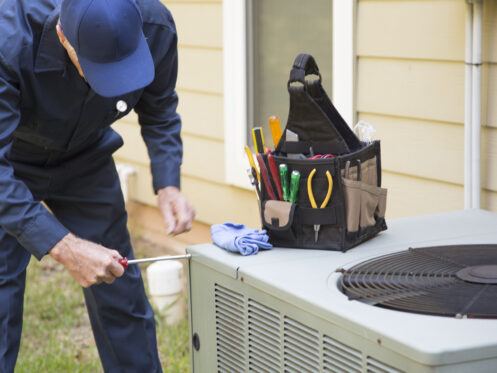Selecting a properly sized air conditioner for your home is crucial, but this task is often easier said than done. Sterling homeowners need an efficient AC system that optimizes comfort while keeping their energy costs low, but not all houses are the same. Moreover, Northern Virginia’s climate brings its own unique cooling system challenges.
The unit must match thoroughly with your living space to enable peak performance. Therefore, you’ll need to understand the essentials of sizing an AC to make an informed decision and optimize your new system’s cooling capabilities. Let’s take a look at how to find the perfect fit for your living space.
Air Conditioning Capacity and How We Measure It
The capacity of an AC unit is determined by its ability to cool a given space. Selecting a unit powerful enough to handle your indoor comfort demands is, therefore, essential.
Your air conditioner’s capacity is measured in British Thermal Units (BTUs) or tons. One ton is equivalent to 12,000 BTUs. This is the energy required to raise the temperature of one pound of water by one degree Fahrenheit. The higher the BTUs or tons listed for the system, the larger the area an air conditioner can effectively cool.
But how do you know the number of BTUs your home requires to stay at a cool temperatue? It starts with understanding your interior square footage. Other factors, such as ceiling heights, insulation quality, and sun exposure can modify the initial number.
It’s not always a simple one-size-fits-all calculation. Nonetheless, we’ll discuss some general guidelines later to give you a reliable starting point. Just remember that, in general, a professional assessment is necessary to arrive at the most accurate measurements.
What Are the Implications of an Improperly Sized AC?
Selecting the wrong size air conditioner can lead to several problems. If the unit is too small, it will run constantly while struggling to cool your home. When your AC works overtime like this, it drives up your energy bill and puts undue stress on your system. This added wear and tear may cause you to need to replace it sooner than planned.
On the other hand, an oversized air conditioner presents its own issues. While it may cool the room at a faster rate, it tends to cycle off before reducing ambient humidity. This creates a cool and overly moist environment that feels clammy and uncomfortable. Short cycling like this also wears out your AC’s components faster while producing inconsistent temperatures throughout your home.
Factors That Determine the Size of Your AC
There’s more to picking the right air conditioner size than knowing your home’s square footage. Several factors influence how much cooling power you’ll need to sustain optimal comfort and efficiency. Familiarizing yourself with these variables ensures that your chosen unit aligns with your home’s unique specifications.
Typically, you’ll want to use your home’s flooring area as the starting point for the calculation. Ceiling height is another consideration. Higher ceilings translate into more volume. If your home has vaulted or cathedral ceilings, you’ll need a stronger AC to circulate air through the additional space.
Your windows also affect AC sizing. They contribute to the volume inside your home while letting in radiant heat from the sun. Well-insulated homes retain cool air better, so you should consider this when sizing your AC.
Local climate also influences your air conditioner’s size. Areas with hotter summers like ours will generally require a unit with more cooling capacity. Since each home occupant can contribute to the heat of the building, other factors include the number of people at your home. Likewise, the appliances and electronics within the home produce heat.
Calculating an AC Size Estimate
To determine the baseline size for your air conditioner, you can start with this basic calculation that deals with your square footage to BTUs ratio. While this formula doesn’t account for all the nuances at your property, it provides a reliable initial assessment.
As a rule of thumb, you should allocate about 20 BTUs for each square foot of your living space.
Here’s some help estimate the BTUs needed based on various home sizes:
- Up to 300 sq ft: 6,000 BTUs
- 300 to 500 sq ft: 7,000-8,000 BTUs
- 500 to 700 sq ft: 12,000 BTUs
- 700 to 1,000 sq ft: 14,000 BTUs
- 1,000 to 1,200 sq ft: 18,000 BTUs
- 1,200 to 1,500 sq ft: 21,000 BTUs
- 1,500 to 2,000 sq ft: 24,000 BTUs
- 2,000 to 2,500 sq ft: 30,000 BTUs
These figures represent general estimates. You’ll have to make further adjustments to account for your property’s unique specifications, including your ceiling height, odd corners, and occupancy. A heating and cooling specialist can help you accomplish this. Experienced HVAC technicians know how to evaluate your home’s precise characteristics to refine these initial estimates.
Evaluating Your Specific Home Characteristics
Your property’s unique specifications are the most critical factor in accurately sizing your AC. As for your home’s occupants, you generally want to add 600 BTUs for each person living at the property. The number of appliances you keep running will also require additional BTUs to compensate.
Sunlight exposure is another consideration. Rooms with windows that catch direct sunlight for most of the day may need more cooling power. We recommend you add an extra 10% in BTUs for these sun-intensive areas. Meanwhile, areas shaded by trees or other buildings may require fewer BTUs. Usually, around a 10% reduction is sufficient.
Smart Technology and AC Sizing
The latest AC smart technologies, such as variable speed blowers, adjust their speeds incrementally to maintain consistent temperatures and humidity levels. This capability allows for precise cooling and lets you consider a slightly smaller unit since the system works more efficiently to achieve the desired comfort levels.
Smart thermostats are another practical innovation. These devices learn your preferences and daily schedule, and they can even adapt based on real-time data like outdoor climate conditions. Such intelligent solutions are engineered to optimize your air conditioner’s efficient operation.
They conserve energy when you’re away before adjusting to your desired temperature as you return. Smart thermostats have more leeway in size selection because the system actively uses its intelligent features to sustain peak efficiency.
These advanced elements, paired with more traditional considerations for AC sizing, mean that you can often opt for a smaller, more efficient unit. Thanks, in part, to their newer intelligent, adaptive designs, smart AC technologies let you maximize comfort while minimizing energy usage.
Finding the Ideal AC Size With Meade’s Heating and Air
At Meade’s Heating and Air we can walk you all through the complexities of AC sizing. We’re the leading AC installation, repair, and gas line maintenance provider in Northern Virginia. Our seasoned HVAC pros can check every aspect of your home to ensure the ideal cooling system that brings you lasting comfort throughout our warm summer months. We can handle all your air conditioner sizing details.
To get started on selecting the perfect AC unit, contact Meade’s Heating and Air today!




